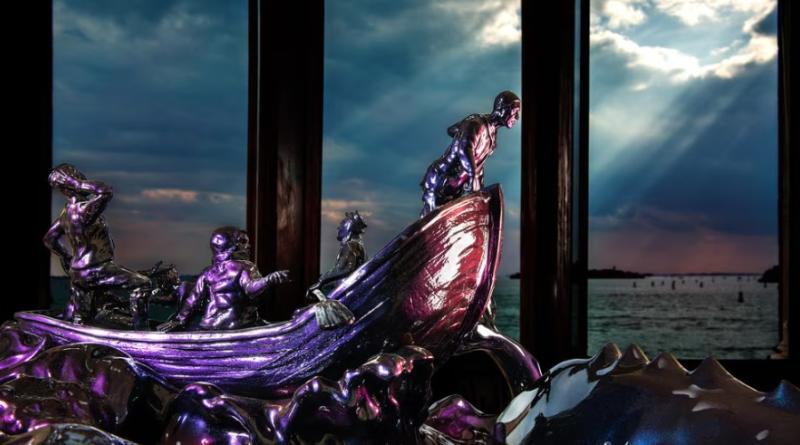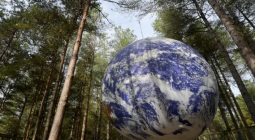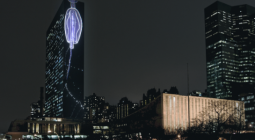‘I’m staggered this isn’t front-page news’: the ‘provocative’ climate art that ended up in a cathedral

Inspired by global warming and the refugees who lost their lives trying to reach Europe, Shezad Dawood’s work asks difficult questions. How will it go down in church?
‘It was harrowing,” says artist Shezad Dawood. He’s recalling the time he cast eyes on the personal effects of refugees and migrants who lost their lives in the sea between North Africa and Sicily. Dredged up from the seabed, these possessions included passports, mobile phones, medicine, cigarette packets – and often, small quantities of earth from their homelands, carefully wrapped in plastic or cellophane. “All were heart-rending, but none more so than the last category,” he says.
The items have been incorporated by Dawood, who is based in Hackney Wick, east London, into the Labanof Cycle, a suite of voluminous, elegiac textile tapestries. First he would paint the various possessions, then they would be screen-printed on to luxurious handmade Fortuny fabrics from Venice. The finished works are archives of loss. Objects that were once banal have become precious fragments of a life to be held on to.
Dawood first encountered the items in 2016 when he visited the Laboratory of Anthropological and Odontological Forensics (Labanof) at the University of Milan. Labanof, which gives the series its name, work with UN rescue teams to retrieve and catalogue the possessions of those who died while attempting to make the perilous crossing to Lampedusa. “Collecting and archiving these possessions helps create closure for the families,” says Dawood. “But the secondary function is to use them as forensic evidence, for the instances when a coastguard had turned a blind eye to a migrant ship in trouble. Now it’s practically government policy to do so.”
A number of Dawood’s paintings are set to hang in a solemn and graceful procession along the main nave of Salisbury Cathedral, as part of his new exhibition at the 803-year-old Wiltshire landmark, titled Leviathan. Among the historic tombs and arches are other works by Dawood on migration, including sculptures and the two most recent episodes of an incomplete 10-part short-film series. Opening just before Advent and running throughout Christmas, it’s an unexpectedly progressive choice for a church.
The Revd Dr Kenneth Padley, the cathedral’s canon treasurer and chair of its arts advisory panel, said Dawood’s installation was “provocative”, but hoped visitors and congregation would understand that “beneath the wrapping paper and joy of the birth of the baby, the Christian message of the incarnation is that God in Jesus comes into the brokenness of this world to transform and redeem it. Jesus himself becomes a refugee, like countless others before and since, as he flees to Egypt from the vengeful King Herod.”
Elsewhere, a resin sculpture painted in scintillating polychromatic paint inspired by Jonathan Swift’s A Tale in a Tub is presented alongside one of Salisbury’s treasures – an original copy of the Magna Carta from 1215. In dialogue with this medieval social contract, Dawood hopes to evoke questions about the perception of migration, and the evolution of human rights through the ages. “If we are already drawing up the bridges, building fences and walls in anticipation, what might we become? Or what might we lose?”
Another persistent, intertwined preoccupation of Dawood’s work in the last decade has been climate change. He has collaborated extensively with oceanographers, marine biologists and political scientists – and has come across research that he is “staggered is not front-page news”. His conversations with specialists feed into Leviathan – the first episode of the Leviathan film cycle was shot in the back rooms of Natural History Museum, and features its famous giant squid.
Each episode takes the viewer on a speculative voyage through the fictional narrative of a character, tracing the challenges humankind faces and imagining possible futures. Episode seven – showing in Salisbury – was filmed in Senegal, and is co-authored by the Senegalese writer Ken Bugul and a social scientist called Africana. It is set in Dakar in 2050, positioning the city as a decolonial model of the future. It moves between documentation and fiction, from the expansive sandy beaches of Dakar to beautiful footage of mangroves, which Dawood has a particular passion for.
“They’re a unique ecosystem sitting between land and sea, between saline and freshwater,” he says. “And they’re such a good defence – for the carbon capture most root systems have, but also as a coastal defence system against extreme weather. There’s a lot to nature-based solutions. We don’t always need a ton of concrete along the coast.”
Dawood is also funding frontline climate research through a non-profit company he established, funded by the sale of his works. But he suggests one of the biggest challenges we’re faced with today is “a lack of empathy, of collectivity”. The ambitious, genre-bending Leviathan project hopes to shift perspectives and bring a much needed “sea change in consciousness”.
Dawood, unlike many who work closely with climate issues, seems to retain a sense of optimism. These latest episodes of the Leviathan Cycle – seven and eight – ask how humanity might evolve, how people might come together. “I didn’t want to only give a critique,” he says, “because how helpful is that? I always wanted to go out and show the faultlines, but then build towards a future. It’s not a full-blown utopia. It’s not this saviour mentality. But it’s asking what the strategies for social organisation are that could get us through.”
The title Leviathan is a reference to Thomas Hobbes’ 17th-century book, as well as Jonathan Swift’s subsequent satire of it, Paul Auster’s 1992 novel of the same name, and several sci-fi films. “I saw it as part of a continuum,” he says. “I really like the idea of not seeking to be a single voice on complex, nuanced subjects.”
In episode eight, Dawood stepped out of the work almost altogether, handing the reins to Indigenous Guarani scriptwriters, directors and activists Carlos Papá, Cristine Takuá and Sandra Benites, and Brazilian artist and researcher Anita Ekman, in the Atlantic rainforests of Brazil. They sent Dawood the footage and he edited it together. The next two Leviathan films are now in the early phases of production. Dawood is looking to film in Korea and Australia. When the 10-episode cycle is finally complete, what will he do? “I will breathe a sigh of relief,” he says. “It’s been such an epic journey.”
-
Leviathan is at Salisbury Cathedral, 28 November until 4 February
Photograph: Courtesy of the artist and private collection - A speculative voyage … part of Shezad Dawood’s Leviathan exhibition at Palazzina Canonica, Venice.





